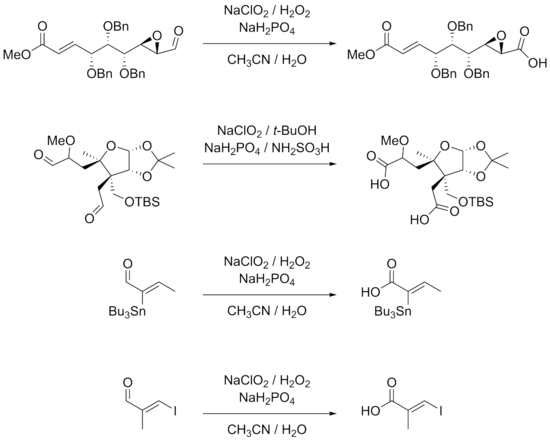Pinnick oxidation
| Pinnick oxidation | |
|---|---|
| Named after | Harold W. Pinnick |
| Reaction type | Organic redox reaction |
The Pinnick oxidation is an
Mechanism
The proposed reaction mechanism involves chlorous acid as the active oxidant, which is formed under acidic conditions from chlorite.
- ClO2− + H2PO4− ⇌ HClO2 + HPO42−
First, the chlorous acid adds to the aldehyde. Then resulting structure undergoes a pericyclic fragmentation in which the aldehyde hydrogen is transferred to an oxygen on the chlorine, with the chlorine group released as hypochlorous acid (HOCl).[6]
Side reactions and scavengers
The HOCl byproduct, itself a reactive oxidizing agent, can be a problem in several ways.[6] It can destroy the NaClO2 reactant:
- HOCl + 2ClO2− → 2ClO2 + Cl− + OH−
making it unavailable for the desired reaction. It can also cause other undesired
To prevent interference from HOCl, a scavenger is usually added to the reaction to consume the HOCl as it is formed. For example, one can take advantage of the propensity of HOCl to undergo this addition reaction by adding a sacrificial alkene-containing chemical to the reaction mixture. This alternate substrate reacts with the HOCl, preventing the HOCl from undergoing reactions that interfere with the Pinnick reaction itself. 2-Methyl-2-butene is often used in this context:
Resorcinol and sulfamic acid are also common scavenger reagents.[6][7]
Hydrogen peroxide (H2O2) can be used as HOCl scavenger whose byproducts do not interfere in the Pinnick oxidation reaction:
- HOCl + H2O2 → HCl + O2 + H2O
In a weakly
- HClO2 + H2O2 → HOCl + O2 + H2O
Chlorine dioxide reacts rapidly with H2O2 to form chlorous acid.
- 2ClO2 + H2O2 → 2HClO2 + O2
Also the formation of oxygen gives good indication of the progress of the reaction. DMSO has been used instead of H2O2 to oxidize reactions that do not produce great yields using only H2O2. Mostly electron rich aldehydes fall under this category.[7] (See Limitation below)
Also, solid-supported reagents such as phosphate-buffered
Scope and limitations
The reaction is highly suited for substrates with many group functionalities. β-aryl-substituted α,β-
The examples of the reactions shown below also show that the stereocenters of the α carbons remain intact while double bonds, especially trisubsituted double bonds do not undergo E/Z–isomerization in the reaction.Lower yields are obtained for reactions involving
Thioethers are also highly susceptible to oxidation. For example, Pinnick oxidation of thio
See also
References
- .
- .
- .
- ^ .
- ISBN 978-0-471-22854-7.
- ^ ISBN 9780124297852.
- ^ .
- .
- ^ .
- .
- .
- PMID 11672125.





